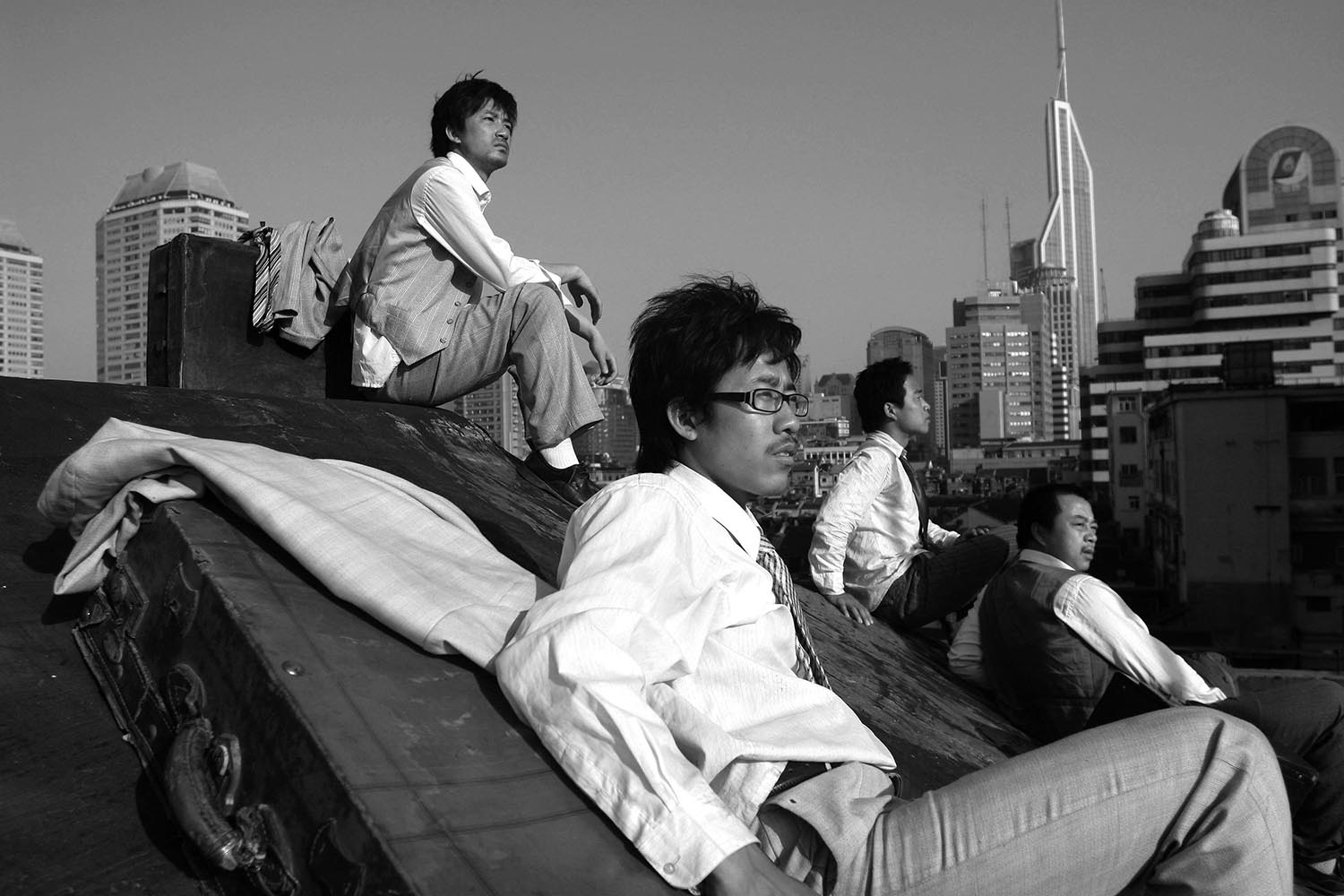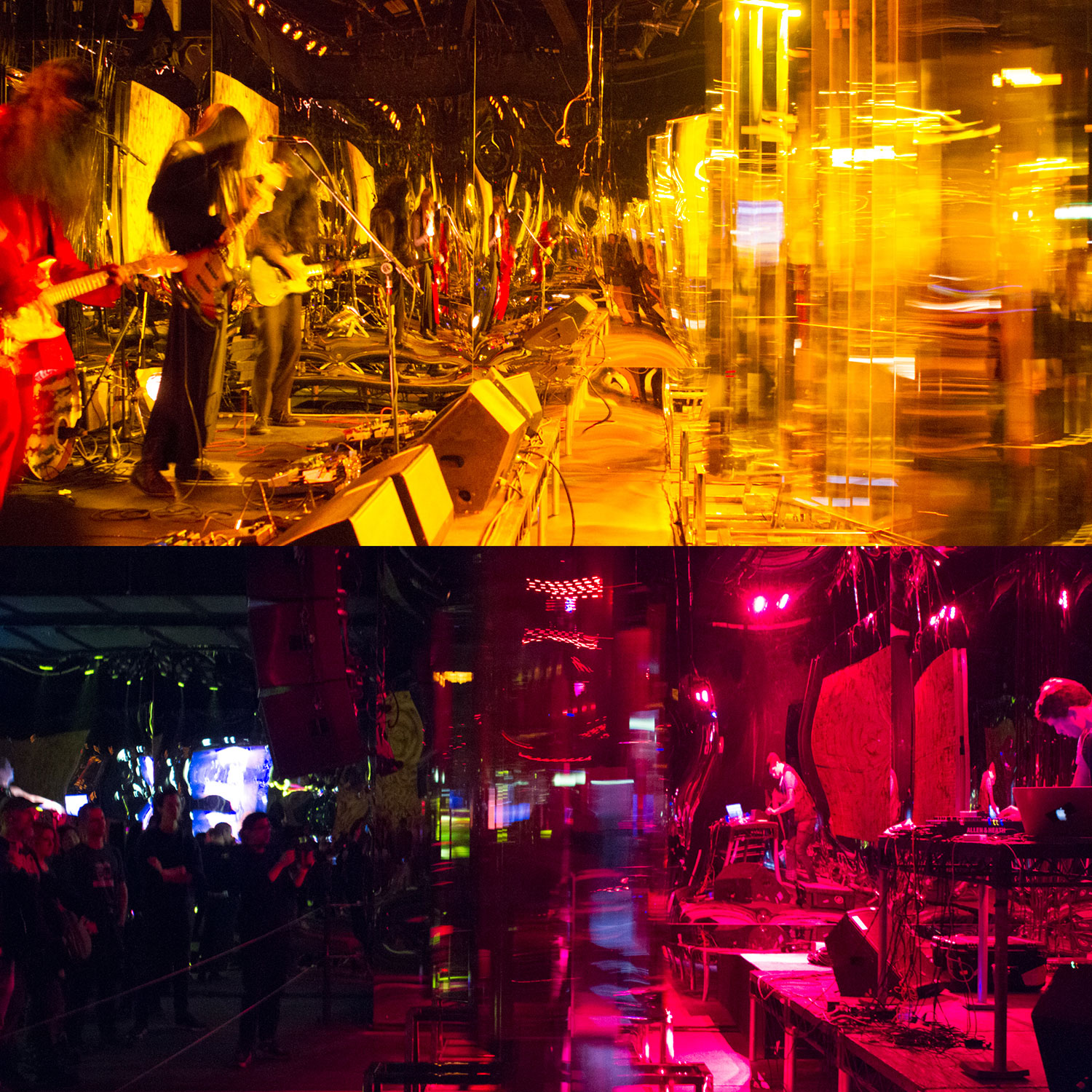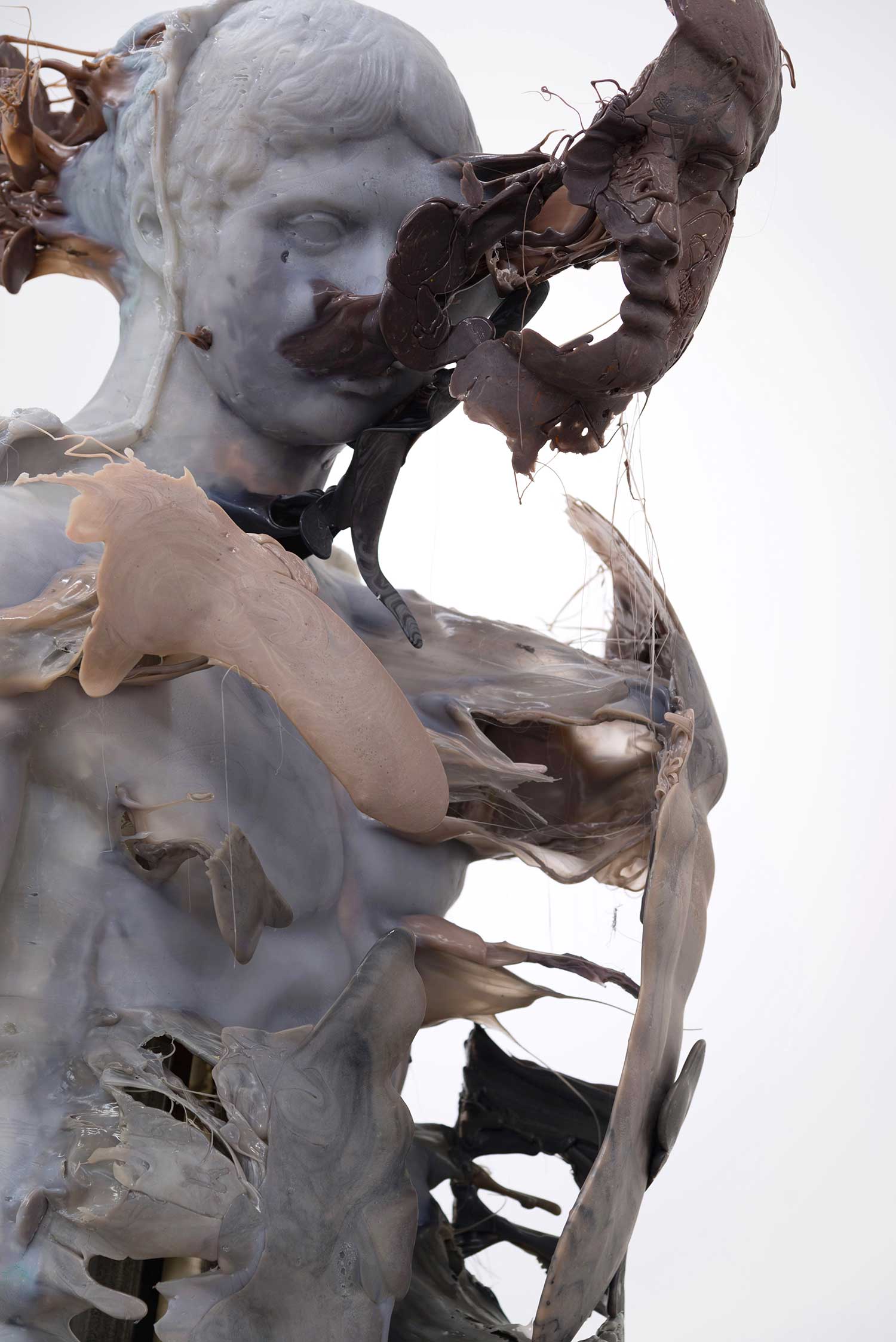
Many of today’s Shanghai-based artists claim inspiration from lao Shanghai (old Shanghai), referring specifically to the early twentieth century when the city bred a particular artistic sensibility referred to as haipai (Shanghai style). Haipai described Shanghai’s flourishing cultural products that combined Chinese and foreign aesthetics, modern and traditional influences, and multiple forms — fine art, fashion, architecture, film. Also implicit in the haipai label was fine art’s growing commercialism. Jenny Lin sits with three of the most historically aware and forward thinking artist/intellectuals working in Shanghai today: writer, critic, curator, and photographer Gu Zheng and artists Liu Jianhua and Yang Fudong. In the following discussion they consider Shanghai’s widely celebrated past and globalized present.
Jenny Lin: You have all created work — photographic series, films, books, exhibitions, sculptural installations — that directly relates to Shanghai. Why is this city a particularly compelling subject for you?
Liu Jianhua: Shanghai has long been a very important Chinese city, especially in the 1920s and 1930s, when it was not only a very famous city in East Asia, but also a center of culture, art and finance. I grew up very curious about Shanghai, because there were a lot of people from Shanghai who worked in the city where I lived. Since the beginning of this century, amid massive urbanization, Shanghai has been at the forefront of new urban construction and economic change. I do not know if this change is good or bad; such questions will only be answered in the future. Since moving to Shanghai from Kunming in 2004, I’ve grown very close to the city, and every day I confront problems in this environment. I’ve deeply contemplated my life here. That’s why I’ve made many artworks related to Shanghai. I also want people to understand the changes and problems of Chinese society through these works.
Yang Fudong: I am very fond of Shanghai, and have grown accustomed to life here. The city has its own unique history, particular style and the feel of a big metropolis. I went to university in Hangzhou, which is very close to Shanghai. The style of China’s southern cities is deeply embedded in my psyche.
Gu Zheng: I think my focus on Shanghai might be a matter of convenience. Of course, I am very interested in how Shanghai is expressed through art, and especially photography. Since I was born in Shanghai, I feel I can discuss the city’s changes and their impacts from a personal perspective through my writings and exhibitions.

JL: You also reference “old Shanghai.” Gu Zheng, you curated an exhibition of Deke Erh’s photographs, which depict Shanghai’s Art Deco architecture in the 1920s and ’30s, and have written about The Young Companion Pictorial, Shanghai’s most popular publication in the 1920s and 30s, and author Zhang Ailing, who chronicled life in Republican-era Shanghai. Liu Jianhua, many of your earlier works from “The Memory of Infatuation and Merriment” (1999–2000) series incorporate women’s torsos clad in qipaos, traditional Chinese dresses often associated with 1920s and ’30s Shanghai and the emergence of China’s modern woman. Yang Fudong, segments of your multi-part film installation Seven Intellectuals in a Bamboo Forest (2003) are set in Shanghai’s former colonial neighborhoods and appear to reference old Shanghai cinema. What interests each of you about old Shanghai? How do you see the relationship between Shanghai’s past and present?
GZ: To some extent, the Shanghai of today and the Shanghai of the past have a historical linkage. By discussing and researching Shanghai’s past, you will better understand the changes in Shanghai today. From my limited understanding, Shanghai’s contemporary art and design do not seem to have many direct connections with 1920s- and 1930s-era haipai, at least not on the surface. But, there may be some deeper links. This is an idea worthy of deeper exploration.
LJH: The use of qipaos in The Memory of Infatuation and Merriment series was not necessarily intended to reflect “old Shanghai,” but rather to signify a special Chinese cultural form of that era. I used these forms to reflect society’s judgment of women and other social issues. I believe viewers will draw connections between these historical forms and current social sentiments, and thus better understand society’s current conflicts. In my more recent work reflecting Shanghai, I’ve hoped to spur other sentiments and complex feelings. We are likely to make judgments based on these kinds of feelings, so I hope my works can stimulate people to attain the experiences and inspirations they desire.
YF: My work is not specifically about “old Shanghai.” Rather, it is about cities, especially Chinese cities, and in particular China’s southern cities, their transformations over time, historical residues, cultural attributes. My feelings about urban life and its evolutions provide the inspiration for my work. My art contains the city’s essential ingredients. When it comes to cities, and also life, it’s very hard for me to discern between “old” and “new.” It’s more a matter of presence; time is just a reference. It’s a way of life — there’s no such thing as past and present; it’s more about imagining the future.

JL: Shanghai has been hailed as China’s most international, fashionable, modern and global city. Liu Jianhua, you’ve created art installations in conjunction with the fashion brand Christian Dior. Yang Fudong, you produced a short film, First Spring (2010), for Prada. Gu Zheng, you’ve curated a series of exhibitions at the gallery in Shanghai’s Bottega Veneta retail space. How do you see these art/fashion collaborations? In general, how would you characterize the relationship between global art and global fashion as they come together in Shanghai?
LJH: Shanghai is a fashionable city — a world city on the cutting edge of many trends. Above all else, artists’ collaborations with famous fashion brands emerge primarily from personal artistic development opportunities or concepts. I think that through these collaborations, one can understand both the form of the artist’s product and the artist’s way of thinking.
YF: I was very happy to have this very beautiful artistic collaboration with Prada. It was also a new learning experience. Prada has a great art foundation, which supports many artists. Because of technological advancements, the introduction of new media, and the internet, distances around the world grow smaller. The newest and most current global trends get realized in everyday platforms. Shanghai is very modern and fast developing — a booming globalized city shining bright like the sun.
GZ: Such collaborations can push people toward new perceptions of art, though only to a certain extent. The impact of such collaborations takes time and patience. Global art may be reflected in global fashions. Sensitive artists can discover inspiration from artistic expression reflected through the union of art and fashion. But, fundamentally it is the union of an artist’s own life experiences, historical consciousness and cultural tradition that truly matters.

JL: Shanghai has also been criticized for its rampant materialism and cutthroat development. Gu Zheng, your exhibitions and writings offer critical insight regarding urbanization and globalization in Shanghai and China. Liu Jianhua, you have produced works that are critical of urbanization and globalization, for example, Export – Cargo Transit (2007), an installation that harnesses the negative impacts of globalization by repackaging and exhibiting as art some of the millions of tons of trash that China imports annually from foreign nations like the United States and Great Britain. Yang Fudong, your early photographic triptych The First Intellectual (2000) presents the young intellectual as bloodied, directionless and alone within Shanghai’s modernized cityscape. What are your feelings about Shanghai’s urbanization and globalization?
GZ: Shanghai’s globalization seems unstoppable. Even more frightening are the subtle rules that get implemented in the name of globalization. How to find, show and illuminate local art that ruminates on or even resists globalization is the challenge of working under the conditions of globalization.
LJH: All processes of urbanization inevitably create numerous problems, many of which require reflection. We should certainly try to avoid the mistakes of the past. As such, some of my works address such issues. However, I also feel everything should be observed individually. Amid urbanization, a city is subjected to certain constraints and damages. An artist can create works through his/her own thoughts on and observations of the problems that urbanization presents. I think this is a very important artistic attitude.
YF: Every city undergoes development and change. Average people living in the city have their own friends, environments and living spaces, and feel more from those places where they actually dwell. Artists should respect their own ideas, honor their true feelings and sincerely create their own works.

JL: Even though Shanghai has been a recurring motif in your work, you also engage other locales. Yang Fudong, you show your art internationally, and also shoot in locations throughout China, such as the countryside of Hebei Province, where you grew up. Liu Jianhua, you exhibit in cities all over the world while continuing to produce work in your hometown of Jingdezhen, China’s historic capital of porcelain production. Gu Zheng, you curate exhibitions internationally and in cities across China, and have also lived in Tokyo, another Asian mega-city. How would you characterize Shanghai in relationship to other cities, both in China and abroad? What is unique about Shanghai? Why have you chosen Shanghai as a base?
YF: My creative work is not confined to one fixed place. I’ll shoot in Shanghai, but also in Beijing, Hangzhou, etc. The defining characteristics and spirit are different in southern and northern China. Depending on what I want my work to express, I will select a location for shooting, considering that each location has its unique characteristics, feelings and spirit. In Shanghai, one also has to consider “time.” Over many years, Shanghai has developed its own remnants and gone through all kinds of changes. Over time, Shanghai has been baptized as a beautiful city. I wouldn’t say that I use Shanghai as a basis for my creation, but over ten years, I’ve lived and worked here. Shanghai is home, where life is.
LJH: I chose Shanghai as a base by chance, since I got a job here. I had long felt that Shanghai was mysterious and intriguing — a city I always wanted to understand. Because of Shanghai’s specific historical development, it has accumulated many special characteristics that set it apart from most other cities. Jingdezhen, where I grew up and went to university, is completely different from Shanghai. Even though both cities are south of the Yangtze River, each has its own cultural roots, historical residues and developmental paths. Shanghai, because of its history, is very similar to Western cities. Compared to other Chinese cities, a lot of people in Shanghai have a more Western mindset. During China’s Republican era, Shanghai was essentially an international metropolis. Today, Shanghai is still an international metropolis. But, compared to previously, Shanghai now needs to be more open to integrating global cultural developments. Today’s Shanghai has the potential to become more dynamic, open and creative.
GZ: Honestly, nowadays Shanghai does not have a great deal of its own features. The city’s character can be described in terms of historical inertia. What happened to Shanghai’s character after 1949? Some people think Shanghai has an air of socialism, but I feel its socialism is negligible, hardly having any impact on Shanghai’s current climate. When we discuss Shanghai’s character, we need to understand from what point of view we are looking. When looking at the city from the outside, there are in fact no special characteristics. Looking internally, the spirit of the city is basically defined by the same requirements of any international business city. Perhaps these are Shanghai’s special characteristics. The city’s art does not tend to offer social reflections; artists in Shanghai usually focus more on personal issues and individual styles. Of course, this is the general nature of the entire Chinese art scene today. As for why I’ve chosen Shanghai as a base, that’s because I was born here.

JL: Gu Zheng, you primarily work with and write about photography. Liu Jianhua, you work primarily with porcelain, although your art has become increasingly multimedia. Yang Fudong, you usually shoot films. Please discuss why you are drawn to these particular media, and if you feel these media help you to represent the multifaceted landscape of Shanghai.
GZ: In the hierarchy of art history and art criticism, photography is a relatively new and lowly category. However, I feel lowly categories are more likely to contain deep content worthy of exploration. That’s why I look at photography and photography in cities, especially Shanghai. So far, we don’t have many critical theories and concepts related to Shanghai-based photography. This is an area that needs to be examined further.
LJH:I tend to use ceramic more than other materials. I have a particularly strong relationship with ceramic because I grew up with this material, and I came to use ceramic in contemporary art to explore new possibilities. Each artist choses his/her own distinctive materials and languages, though I do think the current development of art tends to privilege multimedia works. There are many ways to present art, and each artist has his/her own personal direction. I think working with multiple media is quite good. At the same time, I want to use the single material of porcelain to produce many possibilities. This is a primary point of interest in my work.
YF: Every artist uses his or her own creative media and methods. Some choose paint, some choose poetry, some choose theater; film suits me best. I use film as my brush. I cannot represent Shanghai or any other city. I feel like I am a part of the city, and of other places. In different cities, I search for different entry points. Through my own viewing angles, I create the ideas I want to express.
JL: How would you characterize the current artistic climate of Shanghai? In what directions do you think Shanghai’s art scene may be moving?
LJH: I do not know where Shanghai’s art scene will go in the future, but museums and art galleries are certainly multiplying. There are also more and more artists. Young artists are growing faster and faster. Overall, Shanghai’s art scene seems to be moving in the right direction, but a lot of things also need time to continue growing and should then be observed.
YF: Shanghai has many young artists. It’s really great. They have very broad perspectives. Because they’re young, they will think of the “new” and the “future collective.” They are full of uncertainties, and will produce many exciting things — things you cannot predict. Many young artists put all their effort into presenting new art, fully unleashing their creativity. To generate new feelings among the general public is the underlying effort of the “collective.”
GZ: The richness and diversity of Shanghai’s art scene is decent, but there needs to be more work containing social and historical meanings, and the creation of a real local dialogue. I cannot say in what direction Shanghai’s art scene will go, as I can’t predict the future.





